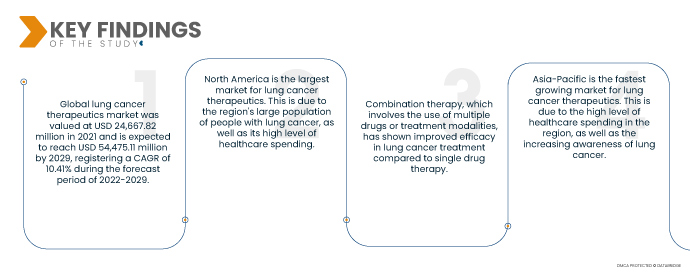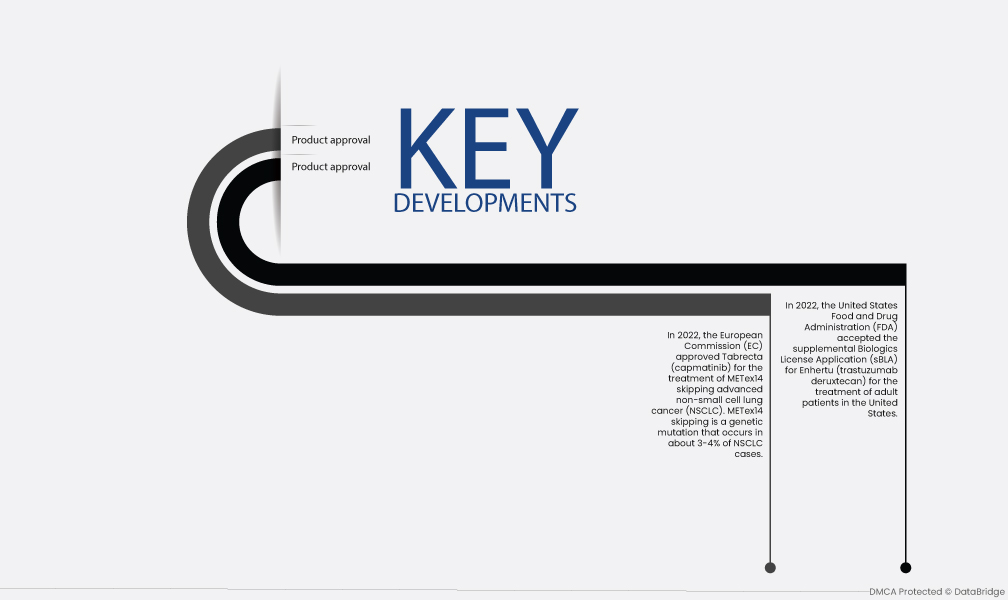Lung cancer (both small cell and non-small cell) is the second most frequent disease in both men and women, according to the American Cancer Society 2022. Lung cancer is the leading cause of cancer death in both men and women, accounting for over 25% of all cancer deaths. Furthermore, while the disease remains the leading cause of cancer deaths among both men and women, the survival rate has increased by 14.5% nationally over the last five years, according to the American Lung Association's 2021 report. As a result, all of these factors have contributed to the market's expansion.
Access Full Report at https://databridgemarketresearch.com/reports/global-lung-cancer-therapeutics-market
Global Lung Cancer Therapeutics Market was valued at USD 24,667.82 million in 2021 and is expected to reach USD 54,475.11 million by 2029, registering a CAGR of 10.41% during the forecast period of 2022-2029. The number of people diagnosed with lung cancer is expected to increase in the coming years, due to a number of factors, including smoking, air pollution, and aging. The cost of cancer care is rising, due to the increasing complexity of treatments and the rising cost of medications. There is a growing awareness of lung cancer, both among the general public and among healthcare providers. This is leading to more people being diagnosed with the disease, and more people seeking treatment.
Growing demand for lung cancer therapeutics is expected to drive the market's growth rate
One of the main drivers of the global lung cancer therapeutics market is the rising demand for treatment. Lung cancer is the leading cause of cancer death worldwide, and the number of people diagnosed with the disease is expected to increase in the coming years. This is driving the demand for new and effective treatments. There have been a number of new and effective treatments for lung cancer developed in recent years. These treatments are more effective than older treatments, and they are also less toxic. There are a number of new treatment options available for lung cancer, and these options are becoming more widely available. This is making it easier for people with lung cancer to access treatment.
Report Scope and Market Segmentation
|
Report Metric
|
Details
|
|
Forecast Period
|
2022 to 2029
|
|
Base Year
|
2021
|
|
Historic Years
|
2020 (Customizable to 2014- 2019)
|
|
Quantitative Units
|
Revenue in USD Million, Volumes in Units, Pricing in USD
|
|
Segments Covered
|
Cancer Type (Non-Small Cell Lung Cancer, Metastatic Lung Cancer, Pulmonary Neuroendocrine Tumours, Mediastinal Tumours, Mesothelioma, Chest Wall Tumours), Molecule Type (Small Molecules and Biologics), Drug Class (Alkylating Agents, Antimetabolites, EGFR Inhibitors, Mitotic Inhibitors, Multikinase Inhibitors and Others), Treatment Type (Chemotherapy, Radiation Therapy, Targeted Therapy, Immunotherapy and Others), Therapy Type (Single Drug Therapy and Combination Therapy), End User (Hospitals, Homecare, Speciality Clinics and Others), Distribution Channel (Hospital Pharmacy, Retail Pharmacy, Online and Others)
|
|
Countries Covered
|
U.S., Canada and Mexico in North America, Germany, France, U.K., Netherlands, Switzerland, Belgium, Russia, Italy, Spain, Turkey, Rest of Europe in Europe, China, Japan, India, South Korea, Singapore, Malaysia, Australia, Thailand, Indonesia, Philippines, Rest of Asia-Pacific (APAC) in the Asia-Pacific (APAC), Saudi Arabia, U.A.E, South Africa, Egypt, Israel, Rest of Middle East and Africa (MEA) as a part of Middle East and Africa (MEA), Brazil, Argentina and Rest of South America as part of South America
|
|
Market Players Covered
|
Church & Dwight Co., Inc. (U.S.), GlaxoSmithKline plc. (U.K.), Pfizer Inc. (U.S.), Sun Pharmaceutical Industries Ltd. (India), Takeda Pharmaceutical Company Limited (Japan), ONO PHARMACEUTICAL CO., LTD. (Japan), F. Hoffmann-La Roche Ltd (Switzerland), Novartis AG (Switzerland), Lily. (U.S.), AstraZeneca (U.S.), Boehringer Ingelheim International GmbH (Germany), Merck & Co., Inc. (U.S.), CELGENE CORPORATION (U.S.), Sanofi (France), Johnson & Johnson Services, Inc. (U.S.), Dr. Reddy’s Laboratories Ltd. (India), ALLERGAN (Ireland), Teva Pharmaceutical Industries Ltd. (Israel), and Bristol-Myers Squibb Company (U.S.)
|
|
Data Points Covered in the Report
|
In addition to the market insights such as market value, growth rate, market segments, geographical coverage, market players, and market scenario, the market report curated by the Data Bridge Market Research team includes in-depth expert analysis, patient epidemiology, pipeline analysis, pricing analysis, and regulatory framework
|
Segment Analysis:
The global lung cancer therapeutics market is categorized into seven notable segments which are based on cancer type, molecule type, drug class, treatment type, therapy type, end user, and distribution channel.
- On the basis of cancer type, the global lung cancer therapeutics market is segmented into non-small cell lung cancer, metastatic lung cancer, pulmonary neuroendocrine tumours, mediastinal tumours, mesothelioma, and chest wall tumours.
The non-small cell lung cancer segment is expected to dominate the global lung cancer therapeutics market
Non-small cell lung cancer segment is projected to lead with the market share 49.2%. Non-small cell lung cancer is the most common type of lung cancer, accounting for a majority of lung cancer cases. It has a higher incidence rate compared to other lung cancer types, which contributes to its dominance in the market.
- On the basis of molecule type, the global lung cancer therapeutics market is segmented into small molecules and biologics. The dominant segment in the molecule type category can depend on factors such as the availability of approved therapies, research and development focus, and market preferences based on efficacy and safety profiles.
- On the basis of drug class, the global lung cancer therapeutics market is segmented into Alkylating Agents, antimetabolites, EGFR inhibitors, mitotic inhibitors, multikinase inhibitors and others. The alkylating agent segment is projected to lead with the shares 30.6%. Alkylating directly damage DNA and prevents the cancer cells cell division. The alkylating agent can be used in every stage of cancer. This drug shows pre and post stage. This drug also shows reduced drug accumulation and the increased detoxification.
- On the basis of treatment type, the global lung cancer therapeutics market is segmented into chemotherapy, radiation therapy, targeted therapy, immunotherapy and others. The chemotherapy segment is projected to lead with the market share 39.6%. It offers the potential for personalized treatment approaches and improved outcomes, contributing to its dominance in the market.
- On the basis of therapy type, the global lung cancer therapeutics market is segmented into single drug therapy and combination therapy. The single drug therapy segment is projected to lead with the market share 61.0%.
- On the basis of end user, the global lung cancer therapeutics market is segmented into hospitals, homecare, speciality clinics and others.
Hospitals segment is expected to dominate the global lung cancer therapeutics market
Hospitals segment is expected to dominate the global lung cancer therapeutics market with a market share 45.9%. Hospitals serve as the primary healthcare setting for the diagnosis and treatment of lung cancer. They have the necessary infrastructure, medical expertise, and resources to provide comprehensive care to lung cancer patients, contributing to their dominance as the primary end user segment.
- On the basis of distribution channel, the global lung cancer therapeutics market is segmented into hospital pharmacy, retail pharmacy, online and others. Hospital pharmacy is projected to lead with the market share 52.2%. Hospital Pharmacy is dominating the global lung cancer therapeutics market as the lung cancer therapy products are prescribed based which is majorly available in hospital pharmacy.
Major Players
Data Bridge Market Research recognizes the following companies as the major market players: Church & Dwight Co., Inc. (U.S.), GlaxoSmithKline plc. (U.K.), Pfizer Inc. (U.S.), Sun Pharmaceutical Industries Ltd. (India), Takeda Pharmaceutical Company Limited (Japan), ONO PHARMACEUTICAL CO., LTD. (Japan), F. Hoffmann-La Roche Ltd (Switzerland), Novartis AG (Switzerland), Lily. (U.S.), AstraZeneca (U.S.), Boehringer Ingelheim International GmbH (Germany), Merck & Co., Inc. (U.S.), CELGENE CORPORATION (U.S.), Sanofi (France), Johnson & Johnson Services, Inc. (U.S.), Dr. Reddy’s Laboratories Ltd. (India), ALLERGAN (Ireland), Teva Pharmaceutical Industries Ltd. (Israel), and Bristol-Myers Squibb Company (U.S.).
Market Development
- In 2022, the European Commission (EC) approved Tabrecta (capmatinib) for the treatment of METex14 skipping advanced non-small cell lung cancer (NSCLC). METex14 skipping is a genetic mutation that occurs in about 3-4% of NSCLC cases. Tabrecta is a kinase inhibitor that targets the MET gene, and it has been shown to be effective in patients with METex14 skipping NSCLC. Tabrecta is a once-daily pill that is taken orally. It is generally well-tolerated, with the most common side effects being diarrhea, nausea, and vomiting.
- In 2022, the United States Food and Drug Administration (FDA) accepted the supplemental Biologics License Application (sBLA) for Enhertu (trastuzumab deruxtecan) for the treatment of adult patients in the United States with unresectable or metastatic NSCLC. Enhertu is a HER2-targeted antibody-drug conjugate that has been shown to be effective in patients with HER2-positive NSCLC. Enhertu is administered as an intravenous infusion every three weeks. It can cause more serious side effects, such as infusion reactions, cytopenias, and pneumonitis.
Regional Analysis
Geographically, the countries covered in the market report are U.S., Canada and Mexico in North America, Germany, France, U.K., Netherlands, Switzerland, Belgium, Russia, Italy, Spain, Turkey, Rest of Europe in Europe, China, Japan, India, South Korea, Singapore, Malaysia, Australia, Thailand, Indonesia, Philippines, Rest of Asia-Pacific (APAC) in the Asia-Pacific (APAC), Saudi Arabia, U.A.E, South Africa, Egypt, Israel, Rest of Middle East and Africa (MEA) as a part of Middle East and Africa (MEA), Brazil, Argentina and Rest of South America as part of South America.
As per Data Bridge Market Research analysis:
North America is the dominant region in the lung cancer therapeutics market during the forecast period 2022-2029
North America is the largest market for lung cancer therapeutics. This is due to the region's large population of people with lung cancer, as well as its high level of healthcare spending.
Asia-Pacific is estimated to be the fastest growing region in the lung cancer therapeutics market in the forecast period 2022-2029
Asia-Pacific is the fastest growing market for lung cancer therapeutics. This is due to the high level of healthcare spending in the region, as well as the increasing awareness of lung cancer.
For more detailed information about the lung cancer therapeutics market report, click here – https://www.databridgemarketresearch.com/ru/reports/global-lung-cancer-therapeutics-market














